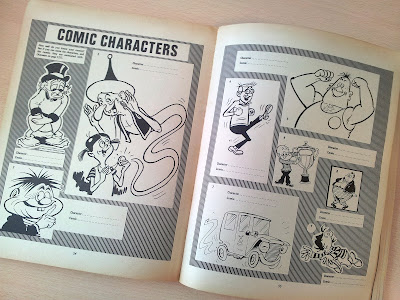|
The feature appeared in the first issue of SHIVER AND SHAKE and
continued until issue 74, missing three weeks inbetween (it was not included in
issues 55, 71 and 72). Tom Williams was the original artist until issue 19 when
Terry Bave took charge (Terry Bave also illustrated the episodes in issues 12
and 17). Starting from issue 32 it was moved from the inside pages of SHAKE to
the back cover of the section and given the privilege of full colour
presentation (except in issues 34, 53 and 54 when it turned b/w for a while).
|
welcome and enjoy!
Hi and welcome to my blog about comics from other people’s childhood! It is dedicated primarily to British humour comics of the 60s and 70s. The reason they are not from my childhood is simply because I didn’t live in the UK back then (nor do I live there now). I knew next to nothing about them until fairly recently but since then I’ve developed a strong liking for the medium and amassed a large collection, including a number of complete or near complete sets. My intention is to use this blog as a channel for sharing my humble knowledge about different titles, favourite characters and creators as I slowly research my collection.
QUICK TIP: this blog is a sequence of posts covering one particular comic at a time. The sequence follows a certain logic, so for maximum results it is recommended that the blog is read from the oldest post up.
Copyright of all images and quotations used here is with their respective owners. Any such copyrighted material is used exclusively for educational purposes and will be removed at first notice. All other text copyright Irmantas P.
Wednesday, April 24, 2013
A LOOK AT SHIVER & SHAKE STRIPS: THE DESERT FOX
Tuesday, March 26, 2013
A LOOK AT SHIVER AND SHAKE STRIPS: WEBSTER
Illustrated by Terry Bave, the b/w feature was launched in SHIVER AND SHAKE No. 1 and continued until the last issue, missing three numbers towards the end of the run (Nos. 74, 76 and 78). It had a permanent slot on page 5 of the paper and was part of SHIVER section but was suddenly transferred to SHAKE starting from issue 44 (cover dated 5th January, 1974 - the first issue with the page count reduced from 36 to 32). Perhaps it was not ‘scary’ enough for SHIVER, or maybe space became scarce in the section after it lost 4 pages.
Webster survived merger with Whoopee! and appeared there occasionally until 1976.
Friday, December 14, 2012
COR!! BOOKS OF GAGS
Terry Bave signed the gags with his real name but Sid Burgon used the pen-name SWAB. My impression is that SWAB was the biggest contributor in both books. Sid Burgon’s cartooning style was different from the one he used in comics, but it is still recognisable if you take a good look. Here are some examples:
























